North Texas' Power Air Raid: Mesh
A staple of the Air Raid, a tool in the Morris toolbox
What we now know as the Air Raid is mostly a marketing trick. Mike Leach told a story about how someone brought an actual air raid siren to the games and would play it after touchdowns. Hal Mumme and Mike Leach’s offense needed a name and that was that. The system, as it was, is pieced together from other offenses. Famously Mumme and Leach went to BYU and learned from Lavell Edwards. BYU was throwing while everyone else was running, and the West Coast-style offenses were throwing short when everyone else was tossing deep passes.1 Everyone learns from everyone (steals) and it has always been this way. Mumme and Leach mostly had the right kind of attitude to do things unconventionally and stick with it. They believed, so their players believed, and it was successful. The offense is mostly a set of beliefs, in practicing, and concepts and an approach to doing offense. You want your guys to have repped a small number of plays and to be able to run them from a lot of formations at a high tempo. The goal is to make it maximally confusing for the defense, while as simple as possible for the offense. That, is the “Air Raid.”
Since it was the offense successful for undersized, tiny Iowa-Wesleyan and Valdosta State, Mumme got better jobs, and so did Leach. Both spawned some disciples — former players and coaches, and so on.
Mesh
For a long while, a staple of the Air Raid was 92. You’ve seen it in video games and probably even came up with a version yourself playing in the backyard. I remember the first time I “ran” this play was in the street when my uncle told me and my brother to run and cross paths down the field, and he’d throw it to whoever was open.
The BYU Cougars ran a version of Mesh with the backs. The reads are the quick out first, and if that’s not open, throw the mesher (shallow crosser) underneath. If that’s not there, you find your dig route over the top.
Compare with Eric Morris’ version, which is not too much different. Here the first read is the Z-receiver. The second is the mesher, or X-receiver coming across. Then it would be the dig over the top.
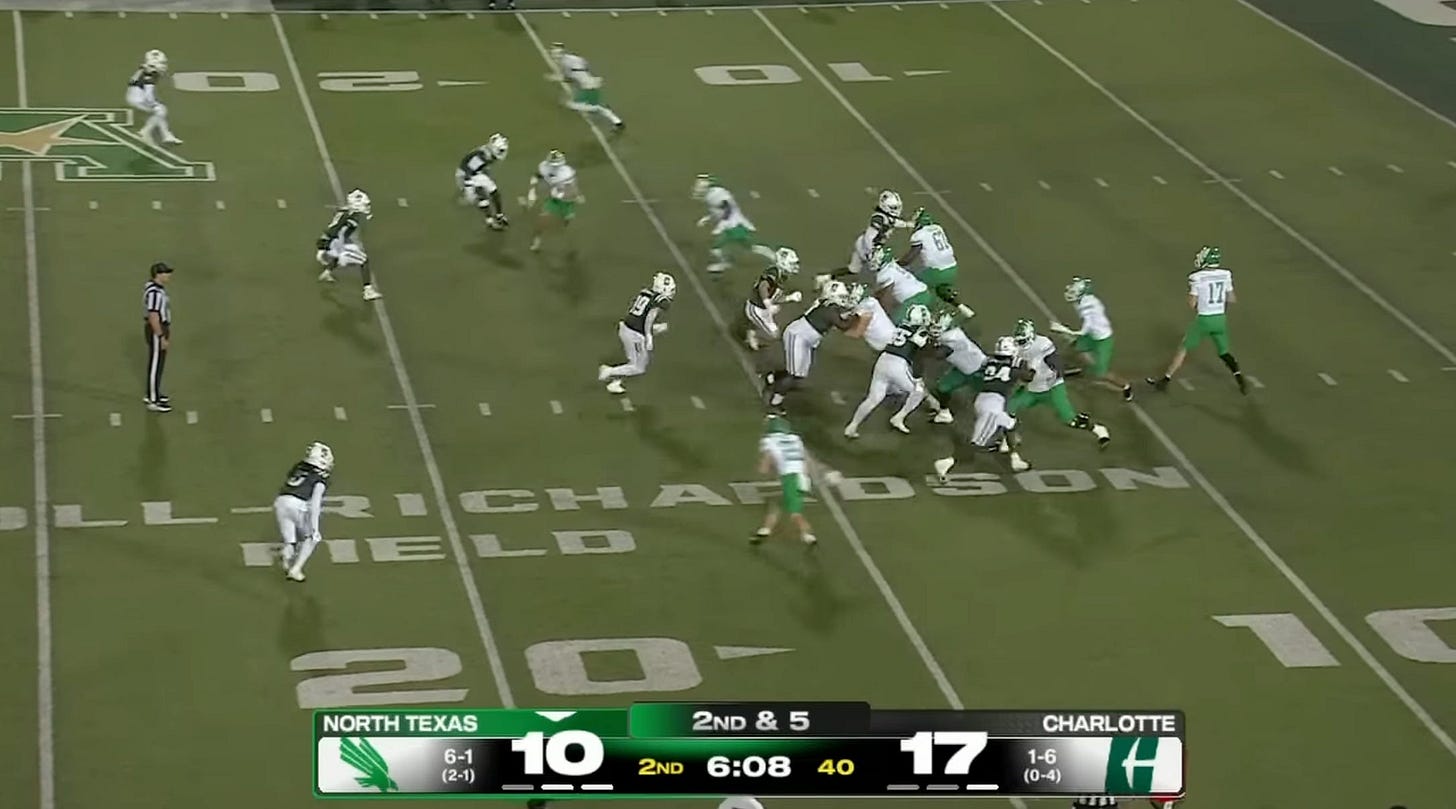
Morris doesn’t call this play very often, but you’ll see it a couple of times per game. That’s one thing about this play and how it clashes with some of the Air Raid’s principles: it is expensive. Dana Holgorsen went away from the play because of that (and because he was tired of coaching it, having done so for 20+ years) but also it took up so much time.
In a clinic, Holgo mentions that he changed the way he taught it to make it simpler, and added a wrinkle. We’ll get to that later.

Morris’ version is not too different than the Mike Leach version, who famously “didn’t change [anything].” You see the reads are the same, and the coaching points a little more clear, but running this play is about making reads, and having answers to whatever is thrown at you. He quick out is adjusted for cover-2, where it converts to a corner. The mesh/shallows are converted to sit routes vs zone, and divides vs man.
That aspect of it is where you get the most coaching headaches. Often guys will need lots of reps on the intricacies of what is man or zone or what is grass or not. The QB/WR reads need to be the same. Lincoln Riley says “It’s more important that they be on the same page, than they be right.”
Last year we saw Chandler Morris and his receivers struggle on this (and really, a lot of things) highlighting how many reps you need to get comfort.
There are a lot of coaching points and subtle differences you can make. When do you get off of your first read? Where should the meshers target — Lincoln Riley says he still teaches the “handclap” thing. Holgorsen said he stopped doing that because the guys would be looking for the handclap and “not at the QB.” Holgorsen teaches them to run toward the tackle and then make a read, a change to what he used to do “just run through.”
Lincoln Riley teaches his Mesh pretty much the same way. The first read is the outside receiver, the mesh goes “right over left” and the right side sets the depth. They clap hands, and the backs are check-releases.
Eventually, defenses start getting wise to these things, and like to sit in some zones (Rip/Liz stuff) where they can match up with the crossers and sit on the reads. The answers come in tagging different variations. Chris Brown of Smart Football once called the Mesh play something like the “veer for option teams” and you can see how it could lull teams to sleep, and then you hit them with something different. Tag a post instead of that quick out, or a zip-route/whip-route from those crosses and you have easy answers to the common hedges.
Motions to get easier throws for the QB (“My QB can’t throw that out route!”)
The most famous example in North Texas history is Mason Fine throwing it to Rico Bussey2.
In the course of tagging things you get some common ones and you shorten them. Blue Z-Move 92, H-Wheel becomes Blue Cobra, to Mumme. Well for Holgorsen, instead of tagging F-Wheel, how about you make it the first option? In his version of Mesh, he added the sit/over route that NFL teams started incorporating, which was great as a “traffic” play, that allowed the back to wheel for gains.
Here is the Hologoesen version at his new stop: Nebraska.3
Holgorsen lessened the expense of teaching Mesh by reducing some of the responsibilities. The X receiver doesn’t run the corner, instead he’s an alert/hot route for blitz looks. The primary read is the back, and the right mesher - Y - is now a clear out guy. “Take them out. You aren’t getting the ball. If you take out the umpire, he middle linebacker, whoever. The better.” The change came in part because of the use of tight ends in his sets more often. It was harder to call the play, and teach it to TEs.
Again, the finer points of the play are so expensive that using up valuable TE time to teach this play when it wasn’t likely going to him was not great. So he teaches his guy to just set the mesh and run, the real target (second to the back) is the mesher on the shallow cross. Finally, the sit route in place of the old Dig over the top gives a zone answer.
The reads are similar — the back, the mesh, the sit. The alert is the X.
When Should We Expect It?
Lincoln Riley says that he loves Mesh anywhere on the field. It is “a security blanket” and because he can dress it up and tag little extras without a lot of fuss, it provides versatility. Eric Morris has typically called this on medium downs. The screen grabs above are 2-&-5 and 3rd-&-4, for example. It’s a great man-beater, and so if you expect some man-to-man looks from the defense, it is great to dial up. The zone-answers are built-in, so if you are wrong, you still haven’t wasted a play-call. When it is blocked up right, the corner ends up being a lead blocker for the mesh guy, as we saw vs Charlotte with Landon Sides taking it for big yards.
Mike Leach loved it in the red zone, with a post tag. Seth Littrell/Graham Harrell loved it there also, and dialed it up for both the post and a wheel (from the back) scores.
It’s a great play. Keep an eye out for it as you watch the Mean Green the rest of the year.
Bill Walsh’s tree had and has a great many disciples. The ideas Wash and pass-first teams have are basically Air Raid type principles. They are all about simplicity and repetitions. The main way the WCO teams and Air Raid teams differ is in the language, with the WCO offense telling basically everyone where to be. The ‘Raid teams simplify this by design, in order to play much faster.
How crazy is it that Nebraska is running the raid? Part of the reason Texas Tech hired Mike Leach was that it new it couldn’t compete with the Nebraskas, Texases, and OUs of the world. Now the Cornhuskers are running the offense that was hired to level the playing field.






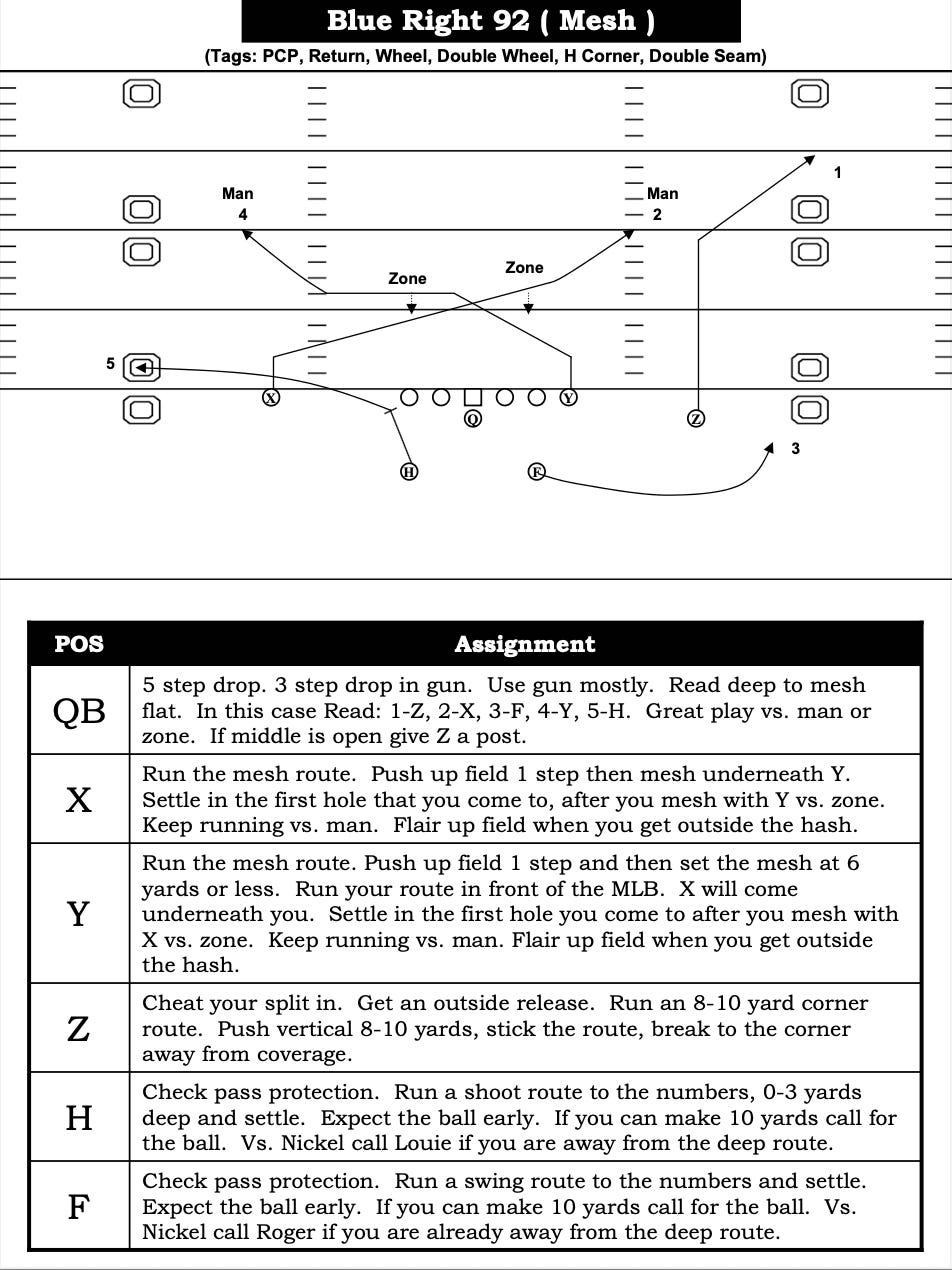

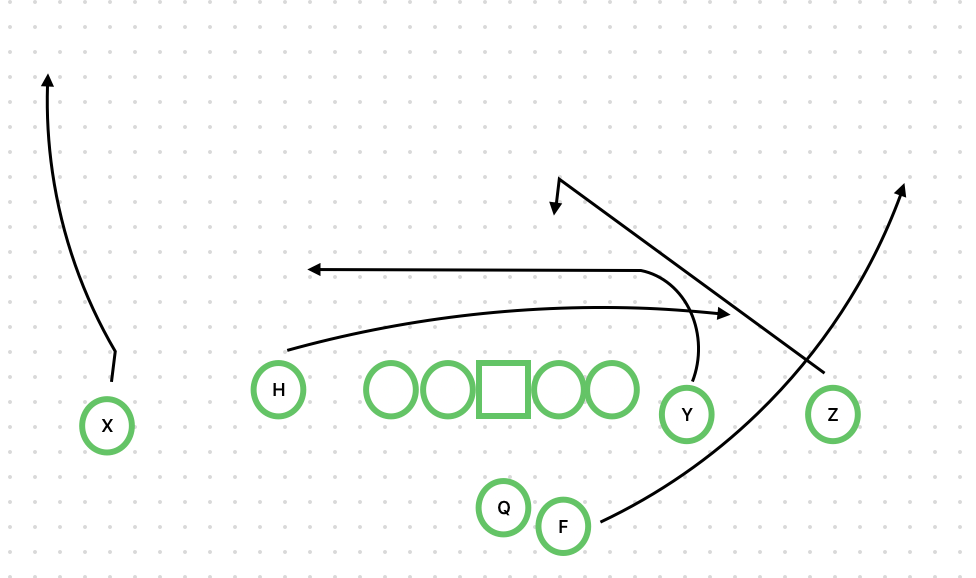
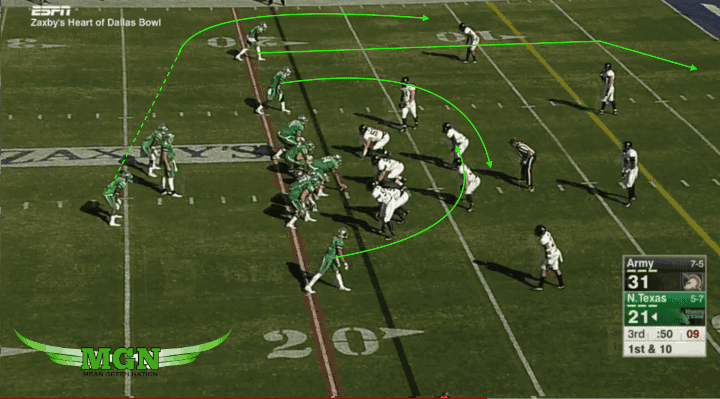
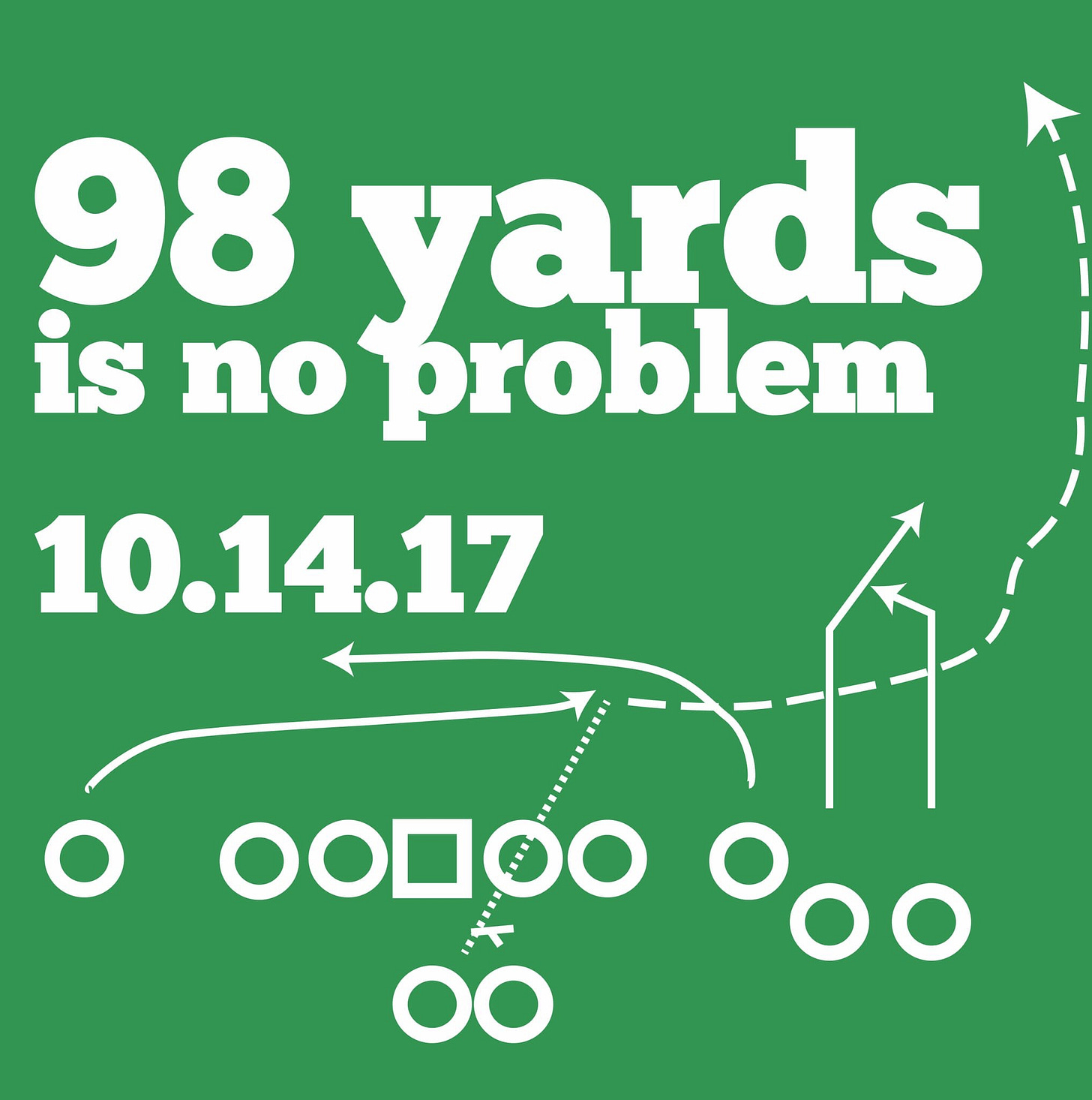
Went back and had to read/re-read some of this article, and it's really "quite" wonderfully written, and (minus a typo indicating EricMorris instead of DrewMestemaker "getting happy-feet" early on) how the writer has a good, intimate grasp of the game of football (perhaps stemming from his time playing alongside future college standouts while back in middle school) and this reader particularly enjoyed the whole spiel about the history of, and differences between, the vaunted "West Coast Offense" (WCO), of the likes of BillWalsh, former Super Bowl-winning coach of the San Francisco 49ers in the NFL, and the (hybrid-or-otherwise) "Air-Raid", such as of LavellEdwards of BYU and his "disciples" HalMumme and MikeLeach, and their respective, subsequent "disciples"!
In summary: the "WCO" is a pass-first scheme that is still drawn-up with set plays in which both the offense, and opposing defense, can learn what the plan is, and execute properly or, in the case of the opposing defense, execute a counter-attack for, whereas, in-contrast, the "Air-Rad" offense is pass-happy, also with WRs focused on as opposed to Tight Ends, but less organized and more no-huddle.
The key pros-and-cons, with that in-mind, is that the WCO, can be sniffed out by the opposing defense and if/when unsuccessful, the general credit for an unsuccessful WCO is given to the opposing defense. It was/is the defender(s)-in-question making a play and earning their money, even a raise.
The Air-Raid being less scheme-and-route-focused, more chaotic, if one will, perhaps, dare this user say, "anarchic", is that it is high(er)-risk, high(er)-reward: If the offense is successful, the credit is given to the offensive player(s), but if the offense is unsuccessful, it's generally due to the offense "sputtering" and screwing-up (for whatever reason, some more forgivable than others), but the opposing defense isn't in a position to really be credited for "making a play". The opposing defense has less of an idea (and, perhaps, therefore the ability) to make a counter-attack and must rely more on the offense in-question messing-up....and/or being gifted two TDs by potentially crooked-or-incompetent referees, if not field-and-weather conditions.
Am, of the two (of course, this user has long had an affinity for that good ol' "smashmouth" academy triple-option running game offense, or at least a...60/40 classic "Dallas Cowboys" offense that is heavy on the run-first approach), preferring the more anarchic "Air-Raid" (maybe call it that instead of "hybrid Air-Raid"? Could be a successful "gimmick"!), because it makes the game of football more like a game of poker, and poker outranks chess and especially checkers. The opponent has less of an idea of what the game plan is to try and scheme against, and the offensive player(s) if/when successful show the world that they're top-tier and capable of learning and adjusting "on-the-fly"!
IMHO, if this user were, say, an NFL or UFL team GM/president, the overall value of such an Air-Raid player showing that they are capable of "on-the-fly" adjustments and learning, but still able to "take orders" is more desirable and should, probably, be more rewarding than a WCO player quite capable of executing a scheme, but has not shown much, if any, ability to go no-huddle or otherwise run and play outside of their usual positional alignments EVEN IF THAT WCO PLAYER WERE FROM A SO-CALLED "P4" PROGRAM!!!
If this user were JerryJones and, in a hypothetical-scenario, The Dallas Cowboys were running an Air-Raid offense, this user would prefer a CalebHawkins to, say, a RogerCraig, formerly of the WCO San Francisco 49ers, because CalebHawkins has shown, despite being a so-called "G6" program player at UNT, the ability to play-ball on-the-fly, but a RogerCraig, despite being a so-called "P4" program player out of NEB, having run more schemed routes than otherwise.
This is how/why CalebHawkins (among others in the past three seasons and, hopefully, in the coming years at UNT with NealBrown at HC) was able to make such history in just his freshman year, out of nowhere, and in a pass-happy offense: Everyone thought The Mean Green were going to pass, and that opened up a running-lane, and even when it wasn't open, CalebHawkins was still able to use his own ability to make one of his own. It's all about discipline and foresight with the Air-Raid, and impeccable execution for the WCO.
Having one of the greatest football players, let alone wide receivers, of all-time in JerryRice DID, however, help both RogerCraig and BillWalsh and the San Francisco 49ers achieve such success, it's just that for undersized and relatively-unknown players and teams, especially in this day-and-age of monopolistic "blue-bloods" wishing to further tighten-their-grip and consolidate their market-share, whether they deserve it or would still retain it in an otherwise free-market.
Push-coming-to-shove, the 49ers of old were not invincible against all defenses, all the time, and being scheme-heavy, opposing "poker players" had the ability to "call their bluff" and capitalize on poor-scheming, even with inferior defensive talent. This user supposes that, in summary, the WCO is more about the "Xs and Os" and the Air-Raid is more about the "Jimmys and Joes".
This fan will take the Air-Raid's allowance of "upward mobility" in the "market", because one can better gauge who is good at what and who is bad at what, giving potential "customers" (such as the aforementioned GMs) a better idea of what they might be "renting".
GMG!
The Solid Verbal's newest (Thursday Bonus) episode suggests that there is a non-zero chance TWO so-called "G6" (it's "P6", people) teams could make the Playoffs, such as The American Conference champion and, likely, The Sunbelt Conference champion, such as a JMU. As unlikely as it is to happen, that'd be f'n AWESOME to see! The American Conference is stronger than The Sunbelt, but The Sunbelt is the closest competition it has for a spot. CUSA, of course Liberty is a historically good-to-great program, on a consistent-basis, at least in the past decade-or-so, is pretty much screwed-over due to its schedule, before the season even began. the MWC is caught in third-place, only ahead of the MAC and CUSA, and it looks like it could be the likes of UNLV vs. Hawaii for the MWC or just one of those vs. someone else.
They also suggested that this scenario would need to see the likes of the ACC completely collapse, such as with DUKE, specifically, collapsing. It's a given The Big 12 would cannibalize itself more so, but it's now top-heavy and the ACC is more even with one another, across-the-board, with more Playoff-relevance this season.
Washington also has a fighting-chance to beat ORE, and "perhaps" knock them out of the Playoffs! Dan'Oh thinks ORE could beat UNT at-home in Eugene, but then lose to 'bama....this listener thinks that UNT has a better chance than others to beat ORE, and that ORE is one of the teams on upset-alert in the Playoffs in their first game vs. whoever, especially given Coach-Morris' time at WAZZU, as a MikeLeach disciple, therefore, having familiar scheming for-and-against the Oregon and Wazzu games, only with a better team than he's had at Wazzu and elsewhere!